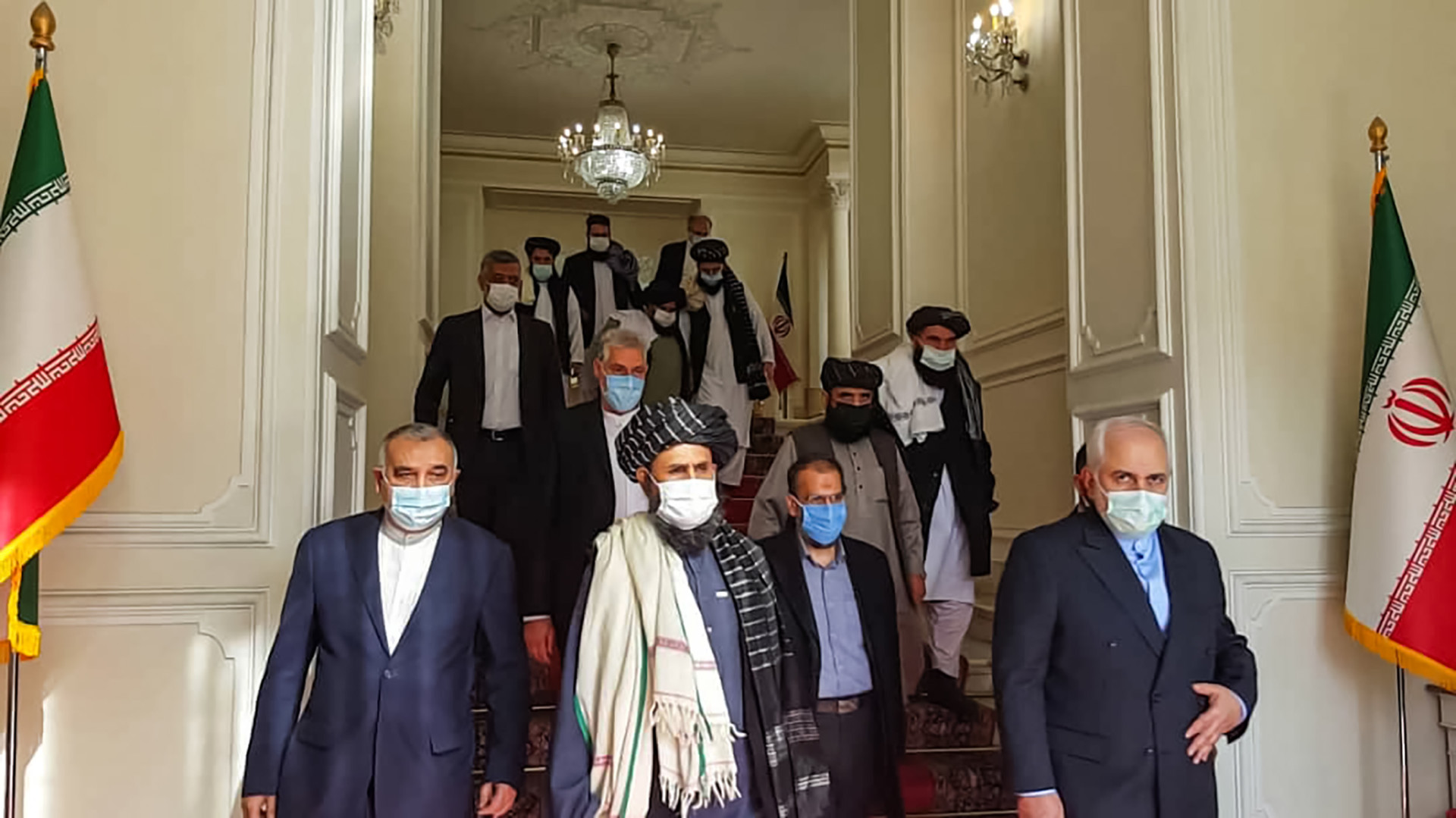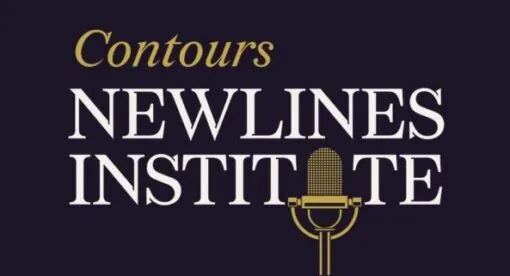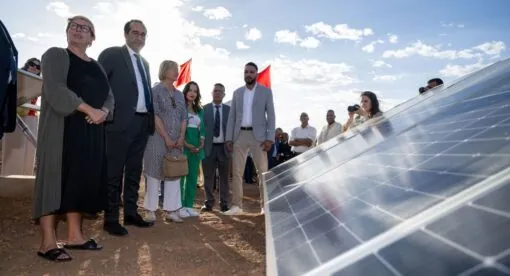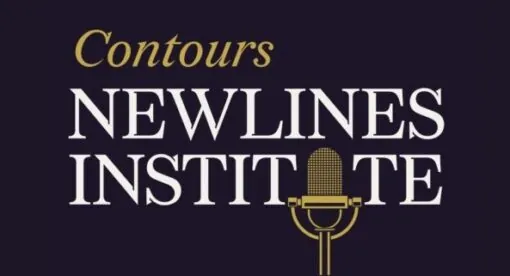Throughout the U.S. war in Afghanistan, Iran has maintained extensive influence in its eastern neighbor. It played both sides of the conflict, supporting the now-deposed government in Kabul while also developing ties with the Taliban. With the Taliban’s takeover of the country in the wake of the withdrawal of U.S. and NATO forces, Tehran will engage pragmatically with the militant group to safeguard and further its national security strategy.
Iran has three reasons for adopting this strategy despite decades of enmity with the Taliban: It needs increased access to water; it wants to secure its borders against hostile actors, refugees, and trafficking; and it seeks to thwart other regional governments’ inroads into Afghanistan. Pragmatism and a determination to take advantage of U.S. missteps will thus set Iran’s path forward.
A History of Hostility
The tenets of the Taliban focus on the modern, revivalist Deobandi sect of South Asian Islam. As a movement founded in the 19th century and committed to a “correct” interpretation of shariah, Deobandism became popular among Pashtuns living on both sides of the Durand Line who engaged in anti-imperial struggles. After the Soviet invasion of Afghanistan in 1979, many Pashtun fighters were drawn from Deobandi seminaries, which received Saudi funding and an infusion of Wahhabism.
In addition to this anti-Shiite religious milieu, it was natural for Iran, a majority Shiite country with a regime dominated by Shiite theocratic clerics, to support the Northern Alliance (dominated by ethnic Tajiks, who are a Persianate people, and other minorities who speak Dari, which is an Afghan dialect of Persian) in its fight against the Taliban during the 1990s. In the battles over northern Afghanistan and the city of Mazar-e-Sharif, where the Northern Alliance’s headquarters were located, the two sides killed thousands, and the Taliban executed members of the Hazara and Uzbek ethnic groups.

In the aftermath of their 1998 capture of Mazar-e-Sharif, Taliban forces killed 10 Iranian diplomats and took hostages at Tehran’s consulate in the northwestern Afghan city. Furor erupted in Iran, and the government mobilized hundreds of thousands of troops to the border. The Taliban insisted renegade members had acted without orders when killing the Iranian diplomats, and the U.N. mediated to defuse the situation.
Compounding the direct assault on Iranian citizens, the Taliban have also slaughtered members of the Hazara ethnic group, which is mostly Shiite. Since its founding, the Islamic Republic has asserted itself as the global defender of Shiism, intervening in varying ways to protect Shiites. Thus, Tehran provided further funding, munitions, and expertise to the Northern Alliance and other groups seeking to defeat the Taliban.
These strategic considerations were behind Iran’s decision to assist the U.S. move to topple the Taliban regime in the aftermath of the 9/11 attacks. Tehran provided critical intelligence to Washington and helped in mobilizing Northern Alliance forces who liberated Kabul before the arrival of U.S. ground forces. Tehran was also active in the Afghanistan reconstruction conference in Bonn, Germany, that led to the founding of the post-Taliban regime under the leadership of President Hamid Karzai, who was the country’s leader from 2001 to 2014.
However, U.S.-Iranian cooperation to effect regime change in Afghanistan proved short-lived. Relations soured, first over the nuclear issue and then over their competing interests in the aftermath of the war in Iraq. Consequently, as early as 2005 Iran engaged in a major policy shift vis-a-vis the Taliban. In the late 2000s and early 2010s, Iran began supporting key elements of the Taliban, which by this time had come back in the form of an increasingly deadly insurgency. Following the emergence of Islamic State – Khorasan Province (ISK) in late 2014, Tehran expanded its diplomatic efforts to include the Taliban. About the same time, the Taliban began to demonstrate a greater understanding of regional politics and global perspectives. The rift between Saudi Arabia and Qatar, where the Taliban long have had a political office, helped bilateral ties between Tehran and the Taliban as Doha improved its own ties with Tehran.
Despite the growth in Iran-Taliban relations and Tehran’s diplomatic moves with Afghanistan’s regional stakeholders, a complicating matter may be Iran’s organization and funding of the Shiite Hazaras. They largely make up the Fatemiyoun Brigades, the paramilitary force that since 2013 has fought in Syria in support of the Assad regime. Prior to the takeover by the Taliban, religio-political leaders expressed concern about the Afghan government’s neglect of the security of Hazara and Shiite areas, the lack of economic opportunities for returning Fatemiyoun (who generally remain fiercely anti-Taliban), and the continued marginalization of these minorities. The treatment of Fatemiyoun fighters was seen even prior to the Taliban takeover as a driver of insecurity and instability in Afghanistan. These concerns remain, especially as to whether the Taliban can or will restrain their fighters and ISK with regard to the Shiites, Hazara, and Fatemiyoun. Former Iranian Foreign Minister Javad Zarif suggested in December 2020 that the then-Afghan government use the Fatemiyoun to fight against ISK. Thus, far, the brigades remain inactive.
Tehran’s strategic policy shift and tentative embrace of the Taliban may begin to pay dividends soon. On Sept. 21, Taliban spokesman Zabihullah Mujahid announced in a press conference the appointment of six Tehran-amenable additions to the interim government. Taliban commanders Mullah Abdul Qayyum Zakir and Mullah Sadr Ibrahim were appointed deputy minister of defense and deputy minister of the interior, respectively. The two represent factions within the Taliban that have received support from Iran for years. With their appointments, the Taliban aim to secure internal unity while improving relations with Tehran: Both men are powerful and independent leaders who command significant forces of their own, which have operated across provinces in the south and west, along the border with Iran.
In addition, the Taliban appointed four other noteworthy individuals to their provisional Cabinet representing ethnic minorities who have been traditionally aligned with Iran. Haji Nooruddin Azizi, a Tajik from Panjshir province, was appointed as minister of commerce. The commerce ministry also got Haji Mohammad Bashir, an Uzbek trader from Baghlan, as deputy minister and Haji Mohammad Azim Sultanzada, another Uzbek merchant from Sar-e-Pul, as second deputy minister. Lastly, Dr. Mohammad Hassan Ghiasi, a Shiite Hazara, was appointed deputy health minister. These appointments come after Tehran publicly denounced the interim government as “not inclusive” and implied that relations would not be amicable.

Security Concerns
Security concerns largely drive Iran’s engagement in Afghanistan, and with U.S. and NATO forces withdrawn, the Taliban are what stands between transnational jihadist groups, especially ISIS, and Afghanistan’s neighbors.
Tehran for this reason has largely ignored clerics, reformists, former President Mahmoud Ahmadinejad, and even Grand Ayatollah Lotfollah Safi Golpaygani, who have publicly voiced their opinions against engaging with the Taliban. Golpaygani, one of Iran’s most senior clerics, warned the government not to trust the Taliban and to remember their “evil actions and killings,” saying that ignoring his warnings would be a “grave” and “irreparable” mistake. Against such criticisms, the administrations of previous President Hassan Rouhani and new President Ebrahim Raisi have sought to convince the Taliban and other groups to form a new political system in which each ethno-religious group has a share in power. Supported by the Islamic Revolutionary Guard Corps (whose current Quds Force commander, Brig. Gen. Esmail Qaani, was for years responsible for the eastern flank, particularly Afghanistan) in its approach, Tehran has worked to mitigate Taliban animosity and reduce future instability within Afghanistan, which will inevitably flow toward Iran.
Putting Iran’s own history with the Taliban into perspective is the attack on the Kabul airport by ISK in late August, a reminder that terrorist groups more brutal than the Taliban continue to exist in Afghanistan. Such groups are opposed by external parties, from the U.S. and China to India, Russia, and Iran, because these groups have roots in sectarian, ethnic, and political conflicts in neighboring countries and regions. Beyond ISK, these groups include al Qaeda’s core, al Qaeda in the Indian Subcontinent, the Haqqani network, the Islamic Movement of Uzbekistan, and the Eastern Turkistan Movement. The Taliban currently enjoy local support and influence among tribal warlords and the Haqqani Network, while al Qaeda has been relatively quiet.
ISK, however, has become increasingly active. Founded by former Pakistani Taliban militants, its members tend to be drawn largely from Taliban defectors as well as radical militants fleeing from the crackdown in Pakistan, particularly on Tehrik-i-Taliban Pakistan and the deeply anti-Shiite Lashkar-e-Jhangvi. ISK has long clashed with the Taliban, claiming their rule is illegitimate and describing them as “filthy nationalists” primarily concerned with gaining power in Afghanistan rather than working to establish a caliphate. The Taliban’s actions in coming to power – working with the U.S. and other governments – help ISK’s rhetoric. Located largely in eastern Afghanistan and across the Durand Line in Pakistan with about 2,000 fighters, ISK – as its name suggests – has transnational territorial ambitions to take over not just Afghanistan but also parts of Uzbekistan, Pakistan, Tajikistan, and Iran. Radical terrorist mobilization in Afghanistan is inevitable.
Because of the number of terrorist groups and their aspirational goals within Afghanistan and against its neighbors, the nascent Taliban government is garnering moderated tolerance from the international community despite its release of thousands of prisoners, including radical extremists, whose technical skills and experience could benefit either the Taliban or another group. Despite their initial inability to convince the Taliban to form an inclusive government, and other inevitable disagreements that will arise, neighbors like Iran will pursue engagement and a “moderated response,” working with the Taliban to restrain or moderate Afghanistan’s most radical extremists and further its information gathering apparatus on such elements. Even with a few of its allies now part of the interim government, Tehran will continue working to keep open the channels of communication and possible influence.
Iran’s Strategy
Iran is among the regional states with which the Taliban have cultivated relationships over the past several years. These governments – including China, Russian, and the Taliban’s long-time patron Pakistan – hedged against the former Afghan government with their own security interests in mind. They do not want the most radical terrorist groups to pursue new opportunities to either thrive in Afghanistan or use the country to launch threats against them or allies like the Hazara.

Often ignored in analyses on Iran-Afghan relations is the issue of water. The two countries signed an agreement in 1973 that requires Afghanistan to release 850 million cubic meters of water from the transboundary Helmand River basin annually. Yet the treaty was not implemented for decades due to wars and conflict, which left Afghanistan’s irrigation and hydropower infrastructure in shambles. Since resumption of dam construction began in 2011, Afghan and Iranian officials have disputed the amount of water released and Tehran’s role in supporting Taliban subterfuge against multiple dam projects. Earlier this year, then-Afghan President Ashraf Ghani reiterated his government’s commitment to the bilateral treaty but stressed that Tehran would have to pay for any additional amounts it wanted: “If you give us oil, you can then ask for (more) water, or give us something in return.” Afghanistan, Ghani asserted, “will not give free water to anyone.” With the Taliban takeover, locals asserted on social media that the group released water from the Kamal Khan Dam to Iran “on orders” from Tehran. The Taliban denied these reports, saying the closure and release of water had nothing to do with Iran.
Iran faces a range of environmental challenges from pollution, high temperatures, flooding, mismanagement, and vanishing lakes. Working with the Taliban and other neighbors to address these concerns is a priority that furthers its national security position.
The most pressing issue facing Tehran and driving its engagement with the Taliban is securing its borders. Tehran wants to avoid open conflict breaking out between the Taliban and ISK and other terrorist groups, as well as Afghan minorities like the Hazara and Turkic Uzbek, and opposition groups like the National Resistance Forces. Iran remains particularly wary of instability in Afghanistan because such volatility increases the number of refugees and amount of trafficking into Iran. Given the ongoing COVID and economic crises, Tehran does not want to face a new wave of migration (it already hosts more than 3 million Afghans), drug-trafficking (an estimated 100 tons annually), and activities from radical extremists on its eastern borders.
In addition, Tehran does not want to give room to opportunists to produce further conflict in Iran’s south and east, where there are substantial Sunni communities and where the Taliban and al Qaeda have sympathizers. Tehran has claimed that these groups have used or precipitated riots over resources as opportunities to weaken the government. Of note are the Salafi separatist groups Jaish ul-Adl and Ansar al-Furqan, the latter of which was founded by Jundallah members after Iran executed the group’s leader, Abdolmalek Rigi. Thus, pursuing a pragmatic line, Tehran has sought to engage the Taliban rather than antagonize them. Because of these relationship-building measures, Iran is one of eight countries still operating its embassy in Kabul (along with Russia, China, Pakistan, Qatar, Kazakhstan, Kyrgyzstan, and Tajikistan).

The U.S. withdrawal of forces across the Middle East and its change in policy toward the region may facilitate increased engagement among long-time rivals that now must deal with each other directly instead of through Washington. This, and the attendant rise of the Baghdad Conference, may be the way forward in de-escalating hostilities between Iran and Saudi Arabia, which in turn could mean closer economic ties between Iran and the UAE. The Raisi Administration has made clear that its foreign policy focus will be with the country’s neighbors: It has appointed Hossein Amirabdollahian, a civil servant with little experience, educational or professional, in Euro-America. Instead, his pedigree focuses on the languages, histories, and relations of the broader Middle East. As Foreign Minister, his dossier will not primarily include nuclear negotiations. Raisi has followed up such appointments with unambiguous language stating that Tehran intends to focus its socio-political and economic efforts in the Middle East and “eastward” regions. For these reasons – and despite mistrust on all sides – Raisi asserted that “the military defeat and withdrawal of the U.S. from Afghanistan must be an opportunity to restore life, security and lasting peace.”
Iran’s strategy in Afghanistan thus also encompasses making inroads and extending its influence in the country. Much is rightly made of the economic losses suffered by Afghanistan because of the Taliban takeover. These losses include the discontinuation of U.S. and EU development aid payments (amounting to 75% of public spending and approximately $11 billion currently blocked) and the anticipated undermining of economic links established over the previous 20 years. The combination of such factors is expected to dent Iranian exports to Afghanistan, which approached $4 billion annually, and contribute to its isolation. However, most Iranian exports to Afghanistan are not easily or cheaply replaced, as evidenced by the Taliban cutting import tariffs and asking Tehran to resume fuel exports after their temporary disruption in August. New trade agreements with Afghanistan could mean Iran receives water instead of money, should that become necessary.
In addition to bilateral economic ties, China’s strategy and its Belt and Road Initiative may play a significant role for Iran. Many have downplayed China’s potential role in Taliban-led Afghanistan, citing few completed contracts and unease on the part of Beijing during this period of economic and political turmoil. However, China was unlikely to sign or pursue projects under a U.S. and NATO-led Afghanistan. Also, while China is also not enthusiastic about the Taliban takeover or the likely conflict to come, Beijing will recognize the Taliban and remain open to opportunities. For this reason, Chinese Foreign Minister Wang Yi hosted Taliban leader Mullah Abdul Ghani Baradar on July 28. Following the Taliban takeover, Beijing on Sept. 9 pledged $31 million in emergency aid to Kabul for food and COVID vaccines. Beijing – like Tehran – will seek economic and diplomatic ways to encourage the Taliban to be attentive to China’s security concerns. In the long term, China may benefit from the over $1 trillion in mineral deposits Afghanistan is estimated to hold, and Tehran may be a benefactor or operate as a regional hub for the BRI and other transport and trade projects.
Also, there is the matter of increased ties with Russia, as part of Tehran’s now-solidified eastward pivot. The geopolitical developments remain complex, but the withdrawal of U.S. and NATO forces is likely to result in solidified existing alignments as well as new relationships, most of which may help Tehran feel more secure and stable. These forthcoming developments include not only socio-political and economic matters but also, importantly, renewed counter-terrorism concerns. Tehran, Moscow, and Beijing already cooperate in this arena, and the Taliban takeover of Afghanistan is likely to bring in Tehran’s Central Asian neighbors. In turn, these three governments will have the chance to deepen their security footprints by building more outposts, engaging in joint military exercises, and shaping a new level of military dependency among neighbors.
Ultimately, Tehran has pursued a pragmatic geopolitical policy with the Taliban to help ensure security and stability. Theologically opposed to and distrustful of the group, Tehran has nevertheless pursued a strategy seeking to benefit itself, its populace, and the broader region. Like its neighbors as well as partners in Beijing and Moscow, Tehran realizes the potential catastrophic fallout if Afghanistan erupts in civil war or is used as a radical terrorist base again. In seeking a stable Afghanistan, Tehran hopes to strengthen economic and political ties with its neighbors that would help protect its economy from non-regional actors.
Dr. Neda Bolourchi is Associate Director of the Center for Middle Eastern Studies and Post-Doctoral Assistant Professor of Middle Eastern Studies at Rutgers University-New Brunswick. Dr. Bolourchi’s research examines the transformative discourse on Iran as sacred during the 20th century across the political and religious spectra. Her work has appeared in a variety of Jane’s publications, Congressional Quarterly’s Political Handbook of the World, Praeger Security International, and the Atlantic Council’s Iran Source.
The views expressed in this article are those of the author and not an official policy or position of the Newlines Institute.






